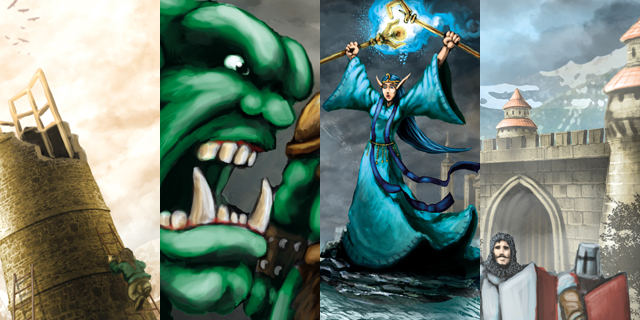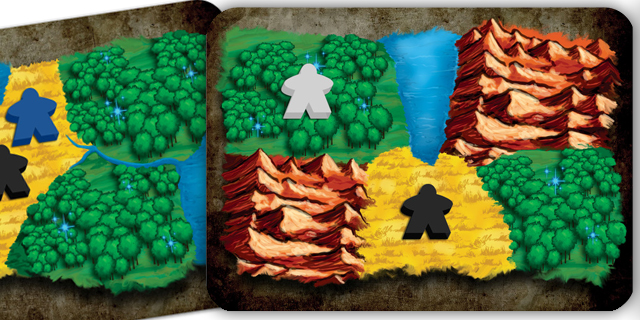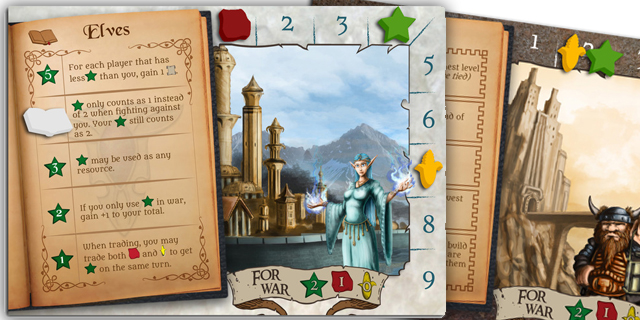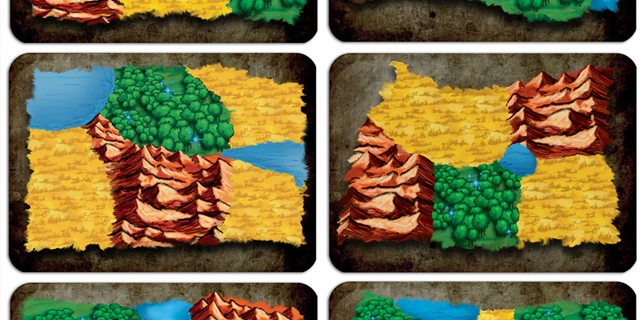
The “4X” (explore, expand, exploit and exterminate) genre is one more familiar and accessible to PC gamers (e.g., Civilization, StarCraft) than it is to the cardboard crowd. The most well-known 4X board games are usually epic, sprawling affairs like Twilight Imperium, Age of Empires, Eclipse or even Civilization: the Board Game. These games have their devotees, but turn away many with their intensive session times, excessive number of pieces, intricate rules, or any number of other factors.
Combining traditional 4X gameplay with the recent design trend towards “micro-games” — games with minimal components that can be played in under 20 minutes — has resulted in Scott Almes’s Tiny Epic Kingdoms, published by Gamelyn Games (Dungeon Heroes). TEK actually has a play time of about half an hour, but that’s still at least one-eighth the time commitment of a normal 4X so the “micro” label still fits. But can you really condense 4X gameplay into a box the size of about two DVD cases stacked on top of each other?
Surprisingly, the answer is “yes,” for the most part. Making up the bulk of the content in TEK are 21 postcard-sized boards. Eight of these are double-sided territory cards, each with five available regions and the occasional obstacle. The other thirteen are faction cards, depicting the different races that players can use in their conquests and the magical abilities each one can learn. The combination of these two elements creates a unique experience every time, giving TEK a lot of replay value.
Each player begins with two of their seven (mini) meeples on one of the region spaces on their home territory. Each player has a total of six resources, divided among mana, food and ore as they see fit. Players also have a token to track their advancement on their magic tracks, as well as the central tower track.

On a player’s turn, they select one of the available actions. Once selected, an action cannot be used again until the action card is cleared, which happens after every five actions. Each player in turn (including the one who selected it) then has the option of either taking the selected action or collecting resources. Each occupied region provides one of its respective resource, to a maximum of nine of any one resource. The trade action will allow you to exchange as much of one resource as you wish for an equivalent amount of another, which can be handy if you are unable to obtain the corresponding regions directly.
There are two ways to claim a new region: the patrol action and the quest action. Patrolling allows you to move one of your meeples to an adjacent region on the same card, while questing lets you move one from a border region of one territory to a border region of another. There is a two-meeple limit for any given region. Doubling up doesn’t provide extra resources, but it does prevent other players from attacking you in that region.
When one player attacks another, both players take one of the twelve-sided dice and secretly sets it to their desired “war power” value, which goes up to 11. Once the values are revealed, both players must pay for their war power using mana (two power per mana spent) and ore (one power). Then whichever one has the highest value claims the region in question while the loser removes their meeple from the board. A player with only one meeple in play cannot be attacked.
The twelfth side of the die is an offer of alliance. This costs no resources, but leaves you vulnerable to any attack by your opponent. If both players offer an alliance, the region is co-occupied. However, if players who have established an alliance later attack each other and one (or both) choose NOT to ally, then war breaks out between them in all of their shared regions. In this case, the losing player has the option of spending three food per meeple to retreat to a neighboring region instead of that meeple being removed. A player cannot lose their last meeple this way, but must spend as much food as they can to keep that last meeple alive (even if they can only spend zero).

When you’re not spending resources on war, the three other actions can put them to use. Build lets you spend ore to advance your position on the tower track. Research similarly allows you to advance on your own faction’s magic track by spending mana. Food is spent on expanding, which places one of your reserve meeples into one of your singly-occupied regions. These costs increase dramatically every time, making it increasingly difficult to max out any given one.
Should a player achieve completion on any one of these three actions (all seven meeples in play, fifth level of research, sixth level of tower) that will trigger the end of the game. Players continue selecting actions until the cycle of five actions has been completed, although if the fifth action was the one to trigger the end the game stops right there. It is also worth noting that nothing can stop the game from ending, even if a player who played their seventh meeple to trigger it later loses one or more fights.
At the end of the game, each meeple in play, each level of researched magic and each level of tower constructed are worth points. Players who have achieved their fifth level of magic often receive some sort of bonus points, as do any players occupying a Capital City region (which provides no other benefit during the game). Ties are broken by position on the tower card, meeples in play, magic level and, finally, total leftover resources.
The faction you choose will inform much of your strategy, as their specific magic abilities will reward certain styles of play. Some factions are more aggressive, others prefer to occupy as many regions as possible and a few are just weird. Whatever your plan, it will pay to keep an eye on what your opponents are doing as well. Knowing when they are vulnerable to attack can save you a lot of trouble, but even selecting an action before they are able to best take advantage of it can set them back a number of turns.

If there is a flaw to TEK, it might be the relative inefficiency of attacking other players. Ignoring the benefit of any faction abilities, war is a costly action whether you win or lose. Winning will often cost you many more resources than your opponent, and if you guess too low you’ve basically wasted your action that turn plus whatever you actually spent on your war power. On the losing end, even a no-resource alliance loss will cost you a meeple, which represents a not-insignificant amount of food to reclaim as well as a general reduction in resource income. As a result, I find that players tend to avoid conflict whenever possible, with most of the war happening once the endgame has been triggered in order to deny points to opponents while spending resources that would otherwise be a distant tiebreaker at best.
TEK supports two to five players, with a minor rules tweak for a full five-player game to give everyone the same chances at selecting the first action each round. A two-player game features a third territory that is occupied by a neutral race. Your opponent spends their resources for the neutral race when you attack it, and regions in the third territory are worth additional points. Obviously alliances are “turned off” in a two-player game as well.
I like having Tiny Epic Kingdoms on my shelf. It provides an experience that few of my other games offer, and unlike its full-sized brethren, it does so in a not-insane time span. I don’t think it will win over any 4X aficionados, but for the rest of us it is a surprisingly robust experience for its size.
Tiny Epic Kingdoms retails for $25.



















